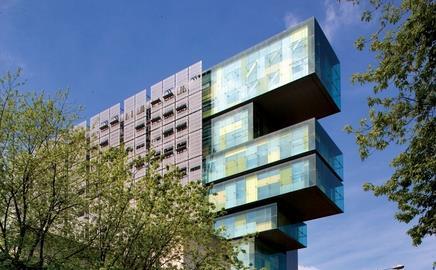In the 14th year of the Building Awards and the second year of the special Building Project of the Year Award, the judges were heartened by the strength and range of the more than 20 entries. So they stretched the normal limit of six shortlisted projects to eight. Martin Spring reviews all of them, including the winner: Manchester Civil Justice Centre
In scale, the shortlisted buildings range from a tiny two-storey spec-built house and a pair of ancillary school buildings to the UK’s largest courthouse in a century and the £224m redevelopment of the underground station at London’s largest transport interchange, King’s Cross St Pancras.
Only two, the Young Vic theatre and the O2 arena, converted from the Millennium Dome in Greenwich, share the same building type, in being cultural venues. The six others are variously: school buildings (at Kingsdale School); spec office development (at Bankside); a spec-built house type (Kingspan Lighthouse); a combined office building and hotel (Fort Dunlop); a court building (Manchester Civil Justice Centre); and a transport hub (King’s Cross underground station). The shortlist is also split evenly between new build and refurbishment.
So in effect, the eight shortlisted schemes come together as a microcosm of contemporary construction in this country – though conceived and executed to a much higher standard than normal. Only one aspect is less evenly spread, and that is their geographic location. Six of the schemes are in London, so it is heartening that the outright winner is a prominent new landmark in Manchester.
Building magazine’s Project of the Year Award sets out to cover the contributions of all sectors of the industry, and this is reflected in the nine judges, who included Jon Emery of property developer Hammerson, Hanif Kara of structural engineer Adams Kara Taylor, Denise Bennetts of architect Bennetts Associates and Bob White, chairman of the Constructing Excellence. As well as being architecturally distinguished, the winning project had to demonstrate an outstanding contribution to the built environment and excellent construction practice. Over the next four pages, we review all eight projects, starting, of course, with the winner: Manchester Civil Justice Centre.
The winner: Manchester Civil Justice Centre
Manchester’s new £113m Civil Justice Centre, an exhilarating 15-storey filing cabinet of a building with all its glass drawers pulled out, emerged as the clear winner of Building Project of the Year.
“The natural daylight in the courts puts people at their ease. It stands as a remarkable piece of townscape at the entrance to the city centre. It was also built to an extraordinarily high quality, and it wasn’t expensive.” That’s how the award judges summed up the project.
The judges were impressed with many different aspects of this building. With a floor area of 24,000m2 which packs in 47 civil courts, it is the largest court complex to be developed in the UK since London’s Royal Courts of Justice was completed in the Strand in 1892. At the same time, it is held up as a model of “Smart PFI”, as it was developed for the Court Service by a private developer, Allied London, but with the design procured separately. The design, by Australian architect Denton Corker Marshall with structural and services engineer Mott MacDonald, was chosen out of 50 entries to an international competition, and the finished building retains all the inspired qualities of the competition design with no trace of cost cutting.
It is the first multi-storey court building, with as many as 10 layers of courtrooms stacked on top of each other to fit into the narrow site. But far from constricting the building, this compaction has in Denton Corker Marshall’s hands generated an exciting multi-storey public atrium flooded in daylight through a clear-glazed facade.
Not least, the building succeeds as a low-energy sustainable environment.
Even the courtrooms stacked alongside the atrium manage to draw natural light and ventilation from both sides, courtesy of an ingenious system of bouncing daylight and fresh air through the atrium and over intermediary meeting rooms. And even when the displacement air-conditioning kicks in, it draws on cool renewable groundwater through 100m-deep boreholes. Through these and other means, energy consumption is reduced by 20% and CO2 emissions by 505 tonnes a year, claims Mott MacDonald.
“Excellent design, procurement and delivery are all combined in this one building,” concluded the judges. On top of that, its many innovations in PPP, sustainable design and architectural excitement are all outstanding and set bold new standards for public buildings.
- Client Her Majesty’s Court Service
- Private developer Allied London
- Architect Denton Corker Marshall
- Structural & services engineer Mott MacDonald
- Quantity surveyor Gardiner & Theobald
- Design-and-build contractor Bovis Lend Lease
Young Vic Theatre refurbishment, south London

Architect Haworth Tompkins has succeeded in upgrading the seventies Young Vic theatre while retaining the low-tech, alternative-culture spirit of the original. As well as refurbishing the original auditorium, a large studio theatre has been added and the public foyer has been opened up as a buzzing cafe-bar and restaurant – all for just £6.9m. Cheap, robust self-finished materials, including angled brickwork internally and metal mesh cladding externally, have been celebrated rather than covered up.
“Evidence of its success is the pleasure with which my team, our artists and our audiences live, work and play in our theatre,” says the Vic’s artistic director, David Lan.
- Client The Young Vic Theatre
- Architect Haworth Tompkins
- Structural engineer Jane Wernick Associates
- Services engineer Max Fordham
- Cladding consultant Montresor Partnership
- Quantity surveyor Davis Langdon
- Main contractor Verry Construction
Music and sports buildings, Kingsdale school, south London

At Kingsdale school, what could have been two low-budget box buildings costing £4m have instead turned out as an inspiring pair of urban sculptures with daylit interiors. The structural potential of large cross-laminated timber panels – essentially jumbo-sized plywood – has been exploited by de Rijke Marsh Morgan Architects to create an eye-catching warped roof to the larger sports building. The adjoining music building comes with a trapezoidal plan and an angular roof to match. The higher cost of the timber was offset by speedy erection and the self-finish for internal surfaces.
- Client Southwark council
- Architect De Rijke Marsh Morgan Architects
- Structural engineer Michael Hadi Engineers
- Service engineer Fulcrum Consulting
- Cost consultant Appleyard & Trew
- Main contractor Galliford Try Construction
Fort Dunlop, Birmingham

Overlooking the M6 motorway in Birmingham, Fort Dunlop gained notoriety to rival Battersea Power Station as a huge derelict hulk of a listed building. Urban Splash had the courage to convert the former tyre warehouse into 32,000m2 of mixed-use commercial space and a 100-bedroom hotel, costing £50m in total.
Shed KM’s design applies bold new interventions while respecting the building’s immense size and structure. An atrium was cut through its deep-plan floors to funnel in daylight. Its two long brick elevations were restored while one end elevation was totally replaced by a modern curtain wall. And a new, blue 175m-long shaft has been slotted through its centreline to house the hotel.
- Developer & contractor Urban Splash
- Architect Shed KM
- Structural engineer Curtins Consulting Engineers
- Services engineer Bennett Williams
- Cost consultant Simon Senton Partnership
King’s Cross St Pancras underground station redevelopment, north London

The £224m enlargement of the underground station at King’s Cross St Pancras formed the first stage of the total redevelopment and expansion of London’s largest public transport interchange, which included creating the new international Eurostar terminus.
The centrepiece of the underground station project was the enlargement of the ticket hall. Enabling works included diverting two main sewers, two large gas mains and an array of water, telecommunications and electrical services. Yet all these major works were carried out with no more than night-time closures of the underground station and road networks.
The project was completed on time and to budget.
- Clients Department for Transport, London Underground
- Development manager Metronet Rail
- Architect Allies and Morrison
- Civil & services engineer Arup
- Cost consultant Franklin + Andrews
- Main contractor Costain/Taylor Woodrow joint venture
The O2 arena, south-east London

The Greenwich Millennium Dome of less-than-glorious millennium celebrations fame has been transformed for £131m into a world-class music venue. The 23,000-seat O2 Arena has already staged sell-out performances from Take That, Prince and the Rolling Stones, and its movable stage can be adapted for banquets and sporting events including the World Gymnastics Championships 2009. Award judges were particularly impressed with the construction feat of raising its 4,000-tonne, 152m-diameter roof inside the existing dome to within just 4m of its fabric shell. This was achieved over six weeks by 16 computer-controlled strand jacks attached to eight concrete cores.
- Client Anschutz Entertainment Group
- Architect HOK Sports
- Structural engineer Buro Happold
- Services engineer M-E Engineers
- Cost consultant WT Partnership
- Main contractor Sir Robert McAlpine
Bankside 123 office buildings, central London

Three stylish spec office blocks totalling 12,000m2 and rising to 13 floors were built behind London’s Tate Modern on time, within the £220m budget and with zero defects.
Several sustainable features were woven into the construction process by Bovis Lend Lease. They included recycling 97% of waste materials, cutting CO2 emissions by 1,500 tonnes by reducing the cement in the concrete and providing construction training for 1,500 operatives. The blocks also add to the South Bank cityscape, as the so-called Blue Fin Building is, as the name suggests, clad in sparkling blue fins and its two neighbours have contrasting terracotta panels set at splayed angles alongside each window.
- Client Land Securities
- Architect Allies & Morrison
- Structural engineer Ramboll Whitbybird
- Services engineer Foreman Roberts
- Cost consultant Davis Langdon
- Main contractor Bovis Lend Lease
Kingspan Lighthouse prototype, Garston, Herefordshire

The Lighthouse is claimed to be the UK’s first speculative house type to meet the stringent level six of the Code for Sustainable Homes and can be built for £180,000. Space and water heating at the net zero-carbon, two-bedroom home are estimated to cost just £30 a year and a prototype erected at the BRE’s Innovation Park in Garston has passed all post-completion testing. It was built using Kingspan Off-Site’s structural insulated panels, which are self-supporting with high thermal insulation. Windows are arranged to admit ample daylight while cutting out solar overheating. Renewable energy generators include photovoltaic panels, solar water heaters and a boiler fuelled by wood pellets.
- Developer Kingspan Off-Site
- Architect Sheppard Robson
- Structural engineer CCB Evolution
- Environmental engineer Arup
- Landscape architect MacFarlane Wilder
- Cost consultant Davis Langdon
- Main contractor Chorus Group
Postscript
Watch videos of all the shortlisted projects at www.building.co.uk/buildingtv





























No comments yet